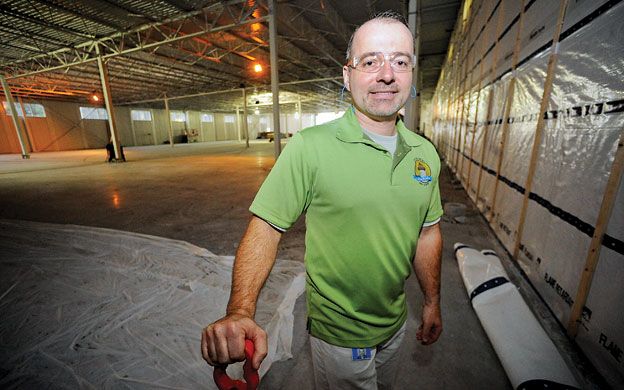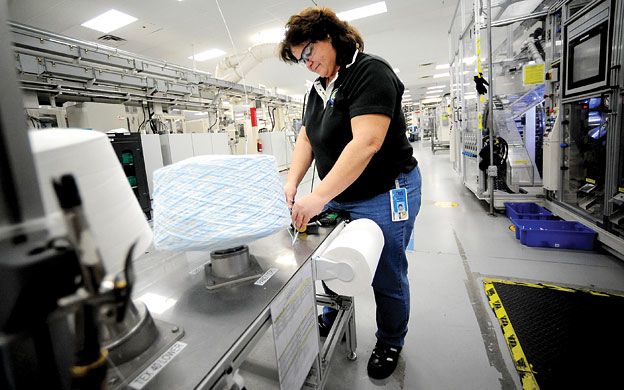Auburn expansion keeps Tambrands at forefront of feminine care
While Auburn's manufacturing sector has historically taken a backseat to its mill-rich neighbor across the Androscoggin, the city has its share of lesser-known industrial accolades.
For example, if you're looking for Maine's largest container port, get off the coast and head to the city of 23,000. The Auburn Intermodal Transfer Facility beats out familiar deep water ports like Eastport and Searsport, moving more container tonnage than any other site in the state.
In the early 1900s, one Auburn factory produced 75% of the world's supply of white canvas shoes, a long-dormant industry that is still memorialized on the city's seal, which depicts a spindle with a different type of shoe topping each of its spokes.
Today, Auburn's manufacturing sector is largely driven by a single product that, while tremendously important to the local economy, will probably never grace the city's seal.
The Tambrands plant in Auburn, owned by Procter & Gamble, produces almost 9 million tampons a day, supplying feminine care products for the entire North American market under P&G's Tampax brand, the worldwide leader in the tampon industry with a 46% market share in 2011, according to research firm Sanford C. Bernstein.
Since purchasing the facility in 1997, Procter & Gamble has invested over $350 million in the 530,000-square-foot facility, allowing the company to make huge strides advancing the Tampax Pearl line, which has captured 30% of the domestic tampon market since being introduced in 2002.
In an attempt to keep up with that growth, Tambrands recently announced a nearly $11 million, 50,000-square-foot expansion that will add three production lines, allowing the plant to increase its potential output of Pearl brand products by as much as 30%, according to Rick Malinowski, Tambrands' external relations manager.
"We've seen very steady growth in the Pearl line. It hasn't been exponential, but it's been steady and strong and this will prepare us to have more capacity for the future," says Malinowski.
The expansion project, which broke ground in July, should be completed by February, with the new lines up and running by May.
"We are investing in our Auburn plant to support the continued growth of our Tampax brand," says Velvet Gogol Bennett, a spokesperson with P&G. According to its SEC filings, the company reported $2.8 billion in earnings as of Sept. 30. Its feminine care division reported $507 million in sales in the same period.
Employment at the plant will stay flat as several older production lines are decommissioned to make room for the new Pearl lines, which now account for two-thirds of the plant's output.
"As more and more consumers are going toward that [product], we need more capacity. We made the decision last year to go ahead and do it, and it's been full-speed ahead since spring," says Malinowski.
An aging domestic consumer base has led to flat and even "slightly declining" tampon sales, according to Malinowski, but the Pearl line — which is more popular with a younger generation of consumers — represents a promising growth market for Tambrands. "There has been a steady transition from cardboard to Pearl," says Malinowski, noting the Pearl products are sheathed in plastic.
Global market potential
Last year saw a low single-digit rise in volume of P&G's feminine care line, driven by growth in developing markets like Central and Eastern Europe, the Middle East and Africa. P&G is the global leader in feminine care products, with around one-third of the global market share, a figure that has held up even during the recent worldwide financial crisis.
"It's affected us like everyone else. If people have lower household income, there might be a little migration to generic brands, but ours is a very personal product — it's not something you want to switch over frequently," says Malinowski. "Our Tampax brand has the highest customer loyalty of all our consumer products."
Tambrands' facility in Auburn makes tampons exclusively for the North American market, but Malinowski says P&G recently installed a Pearl brand production line in Budapest, Hungary, to supply European consumers.
The company is also considering expanding into Asia — its products are already on the shelf in South Korea — but certain cultural differences between the Western and Eastern markets could mean slower growth there.
"We look at Asia as an opportunity area, but there are some cultural barriers around the use of the product that we haven't overcome. It will take time to make that an accepted norm," says Malinowski.
Aside from market potential, Tambrands has other global connections. It was able to weather the European economic crisis' effect on its supply chain thanks to partnership with a German company, which is the world's lone producer of the cellulose-based fiber used in Tambrands' products. Germany's comparatively strong economic position within the European market allowed the fiber company to keep prices steady, says Malinowski.
Personnel production
Not just a production facility, the Tambrands plant houses a machine shop, engineering and quality labs, and is a leading site for the development of new Tampax product research.
But the plant also plays an important role in a different type of development, acting as a sort of farm system for P&G employees.
"We are globally known for our manufacturing capabilities... but we are also an incubator for talent at all levels," says Malinowski, who describes a stint at the Auburn facility as "a real feather in the cap" for up-and-coming P&G executives.
"Auburn has always been a development site, we export so much more talent than we receive," he says. "From technicians to plant manager, we are all committed to the same goal. You get people who, just by the nature of the culture, get well-developed."
Since purchasing the facility some 15 years ago, Tambrands has seen a number of its executive-level employees parlay their tenure in Auburn into a promotion within the corporation. Malinowski says the facility has produced at least one plant manager — who now runs P&G's Always brand facility in Belleville, Ontario — and at least one director.
"They have not only invested here, but thrived here," says Roland Miller, economic development director for the city of Auburn.
"I think the reason, in large part, is because of the quality leadership and management that have been assigned to this facility," he says. "It's been great working with the leadership that has come through here."
Current Tambrands plant manager Felicia Coney serves on the executive board of the Lewiston-Auburn Economic Growth Council, and has been "very active in the community," according to Miller.
"We've been able to continuously interact with [P&G headquarters in] Cincinnati. They are very aware of our plant, the challenges facing it, and don't hesitate to call on us as planning moves forward," says Miller.
Professional development is not just limited to executives at the Auburn plant. A unique shift schedule employed across almost all P&G facilities prevents workers from becoming tied to a day or night shift, allowing them to take advantage of services offered only during normal business hours.
"It allows us to have better contact with all our people so you don't get lost on the night shift. It exposes you to management, project teams and training opportunities so you're not strong on one shift and weak on another," says Malinowski.
The facility is also the city's largest property taxpayer — $1.4 million in 2011 — and the second-largest employer behind Walmart, with about 450 on its payroll.
"The city has been wonderful and very responsive to our needs. All the permitting has gone smoothly and it's been very helpful," says Malinowski.
Miller lauds Tambrands corporate initiatives like the company's zero-landfill project (see "Zero landfill leader," this page) and FlexiCenter customized packaging facility, a division of the plant employing people with disabilities.
"[These] programs are evidence that even as the company examines their bottom line and looks to enhance that, they have also taken a look at how that can be accomplished by giving more opportunities to a greater variety of people," he says.
Miller says the Tambrands plant has helped the region and the state dispel presumptions about being isolated or parochial when it comes to locating a business here.
"They are cited by me all the time to potential corporate clients when we are trying to show them how a relatively small community in the state of Maine can be logistically connected to the world," says Miller.
"This expansion is just continuing evidence that the Maine worker is still one of the most productive in the nation."












Comments